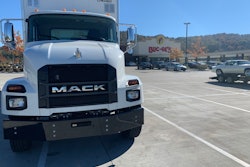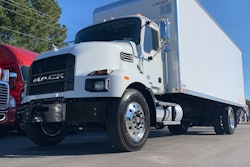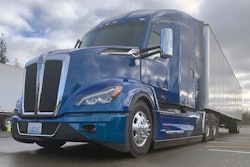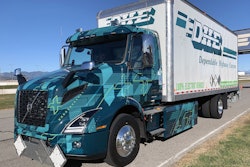
Plus is one of any number of autonomous trucking tech companies battling for elbow room at the table in a future of automated trucks.
Armed with a suite of sensors, the company's first commercial driver assist platform, PlusDrive, is far from a "driverless" tool, rather an added co-pilot layer of safety technologies.
Despite all the space-age tech that Plus has attached to the truck, the most important safety feature still sits in the driver's seat, because with the Plus system the driver is always the captain of the ship. I recently took a turn at captaining the autonomous ship – in this case a PlusDrive-equipped Peterbilt – around Nashville, Tennessee.
Following a systems check – a roughy 90-second process where the Plus system confirms all its components are online and working correctly – we struck out from downtown Nashville toward Interstate 65. The autonomous system isn't designed to provide support on crowded surface roads, so it was on me to get the truck to the on-ramp and headed out toward Louisville, Kentucky.
This autonomous middle-mile – the longest part of the haul – has always been the hunting ground for autonomous tech developers because interstate traffic patterns are more predictable, and tasks that call for mostly driving in a straight line are easier to automate.
Once I get the Pete up to speed, enabling the autonomous functions is fairly simple. Once the system picks up the lane markers, it's just a matter of pressing a couple buttons on the steering wheel – a lot like setting cruise control.
This ain't your Grandaddy's cruise control
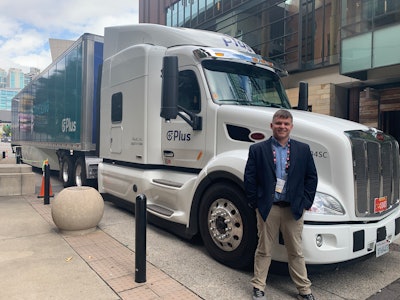 I was recently able to take a PlusDrive-equipped Peterbilt around Nashville.
I was recently able to take a PlusDrive-equipped Peterbilt around Nashville.
Radars, LiDARs and cameras “see” 360 degrees around the vehicle and the fusion-based perception system allows Plus' autonomous trucks to track vehicles hundreds of meters away. Localization and mapping algorithms accurately track the location and update the map with the truck’s surroundings.
Multimodal sensors provide the redundancy to mitigate the effect of sensor failures while also correcting localized environmental noise and boosting precision within their operating range.
Plus trains and deploys a number of deep learning models to perform complex tasks, such as accurately detecting and analyzing ground objects and road structures, and predicting the behavior of the truck and surrounding vehicles.
Soon after enabling autonomous mode, the sensors picked up a car coming up the right-side on-ramp. Based on that vehicle's speed, and based on my speed and the vehicles and space surrounding me, the truck was able to decide how best to allow that car to merge. In this case, the vehicle was building speed and it was obvious that no input was needed.
I know what you're saying right now, "Keep your foot in the throttle. It's not on me to let another car in front of me." That's the legal thing to do, but it's not always the safest behavior. PlusDrive wouldn't have allowed the truck to change lanes on its own, but it would have been able to predict the likelihood of that car running into the tractor or the trailer based on its behavior/speed, and worked to mitigate it to the extent possible (by either staying in the throttle or decelerating) without risking a collision with any other vehicle around me.
There is a trust-building period between the driver and the platform. It's unnerving early on to keep both feet planted on the floor and watch cars weave in front of you, or see the car ahead leaving you knowing that you should be in the throttle and closing that distance. But after a few miles, that relationship starts to develop. The truck's behavior becomes more predicable because the decisions that PlusDrive make are consistent.
It doesn't take long around Nashville to find traffic, and here is where PlusDrive really shines. As passenger cars dipped in and out across my front bumper, the truck managed its own speed and braking. I had to do very little, other than ensure my hands were on the wheel and be aware of "worse case scenarios" – where a passenger car might do the stupidest thing possible.
PlusDrive will brake to a complete stop so there was almost nothing for me to do while fighting traffic other than be on dunce-watch.
While a lot of the on-highway driving experience is automated and doesn't need human input, driver engagement is a requirement. This isn't a fully automated system, and if the platform thinks the driver has mentally checked out (or possibly suffered a medical episode preventing them from controlling the truck), it's going to revert to the safest possible condition: Stopped.
Learning how to dance
After about 15 seconds with your hands off the wheel, you get an audible warning. To clear the warning you only need to put some torque input into the steering wheel or press a button on the wheel. Failing to do so will result in an another alarm 15 seconds later before the truck begins to decelerate.
You really just want to have your hands on the wheel and drive alongside the system. You're not fighting it. It's not fighting you. It's like dancing.
I got the hands-off warning frequently while my hands were actually on the wheel. Since my inputs mirrored the input of the truck, it was sensing that I wasn't actually there. After a while, you learn how to rest your hands on the wheel and not give any manual input at all, which mostly mitigates the hands-off warnings. You can almost feel the torque of it trying to stay on center and you start to learn how to play with it just enough to keep the system happy.
Ruben Cardenas, career trucker and Plus safety driver, noted the fact that a driver is required to keep their hands on the wheel is not only a redundant level of safety, it reinforces Plus' stance that their system is a driver assistance feature, not a driver replacement feature.
"With commercial truck driving, we don't know when we're going to lose a front tire or [the system is] going to ask us to please take over. We might lose a lane line or something like that. We might have glare into the camera at sundown coming in, or a rainy day or just whatever the case may be, and it may ask you to take over," he said. "And if it asks you to take over we want the driver to be ready to take over. So it's a safety thing. It's the way that the system was designed and we don't want to promote complacency."
Behavior of PlusDrive is so consistent that the longer you drive with it engaged, the learning curve shortens because you know what to expect in a particular scenario.
The digital driver interface shows given speed limits, which have been embedded via mapping. Assuming everything ahead of the truck is clear, PlusDrive will increase or decrease vehicle speed to match speed limits as appropriate. You don't have to throttle up or down when you transition through various speed zones.
There's also consideration built in for fuel economy as a fuel algorithm will calculate gear selection and speed based on vehicle weight and road grade.
Many of the automated tasks still require manual inputs, highlighting the importance of the human in the seat being a willing dance partner. Lane changes, for example.
To initiate a lane change, you double toggle the blinker stalk in whichever direction you want. That activates the radar along the side of the rig (all the while still monitoring the semi's forward and rear trajectory) and once it determines you're clear, the system will initiate the lane change. It's important to note that if the system detects a vehicle gaining speed in the lane, it won't move itself over and will defer to that vehicle to clear itself first. So, if you're trying to shoot a tight gap you'll have to do that manually.
I found the system itself very self-selective. I could use the bits and pieces that I wanted and give manual input when I wanted. I never felt the system was there to make me do anything, but was there to take over the tasks I no longer wanted to do.
I mostly let the truck handle throttle and brake but I executed most of the lane changes manually because, in most cases, I forgot I had the ability to do them autonomously. When I want to change lanes, I want to change right then (as soon as it's safe to do so), and I often simply forgot I could let the system make those decisions for me.
In all, I found PlusDrive a valuable piece of driver comfort (less physical and mental fatigue) and can see it as a tool that drives right to the bottom line via increased fuel economy (Plus claims there's a 10% benefit), improved overall safety, and possibly recruitment and retention. PlusDrive, in my experience, isn't a Big Brother safety suite. It's more a Little Brother in that it always defers to its big brother – the human driver.



